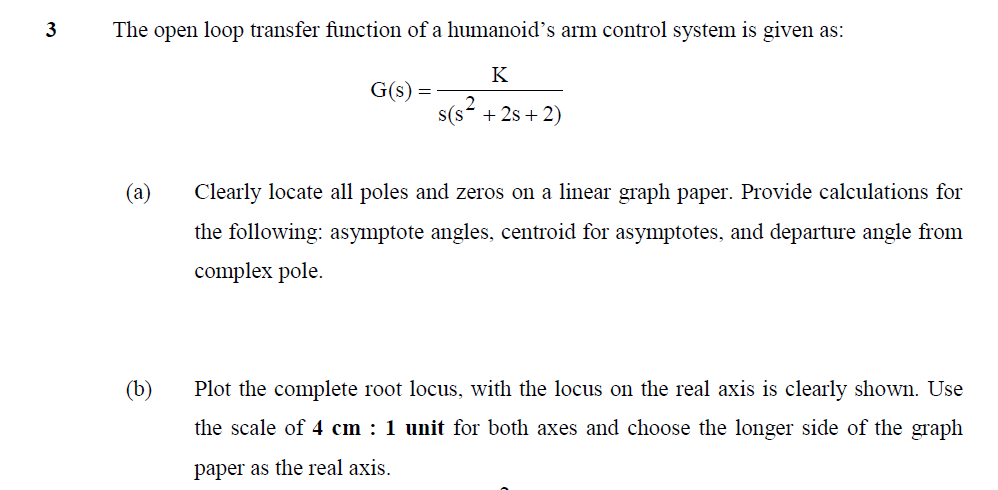3 The open loop transfer function of a humanoid's arm control system is given as: K G(s) = s(s + 2s + 2) (a) Clearly locate all poles and zeros on a linear graph paper. Provide calculations for the following: asymptote angles, centroid for asymptotes, and departure angle from complex pole. (b) Plot the complete root locus, with the locus on the real axis is clearly shown. Use the scale of 4 cm : 1 unit for both axes and choose the longer side of the graph paper as the real axis.
3 The open loop transfer function of a humanoid's arm control system is given as: K G(s) = s(s + 2s + 2) (a) Clearly locate all poles and zeros on a linear graph paper. Provide calculations for the following: asymptote angles, centroid for asymptotes, and departure angle from complex pole. (b) Plot the complete root locus, with the locus on the real axis is clearly shown. Use the scale of 4 cm : 1 unit for both axes and choose the longer side of the graph paper as the real axis.
Introductory Circuit Analysis (13th Edition)
13th Edition
ISBN:9780133923605
Author:Robert L. Boylestad
Publisher:Robert L. Boylestad
Chapter1: Introduction
Section: Chapter Questions
Problem 1P: Visit your local library (at school or home) and describe the extent to which it provides literature...
Related questions
Question
It is control engendering

Transcribed Image Text:(c)
Then determine the operational point, Sm (poles) for damping ratio,
Š = 0.5
Also
determine natural frequencies (On and "d) and gain K at this operational point.

Transcribed Image Text:3
The open loop transfer function of a humanoid's arm control system is given as:
K
G(s) =
s(s- + 2s + 2)
Clearly locate all poles and zeros on a linear graph paper. Provide calculations for
the following: asymptote angles, centroid for asymptotes, and departure angle from
complex pole.
(b)
Plot the complete root locus, with the locus on the real axis is clearly shown. Use
the scale of 4 cm : 1 unit for both axes and choose the longer side of the graph
paper as the real axis.
Expert Solution
This question has been solved!
Explore an expertly crafted, step-by-step solution for a thorough understanding of key concepts.
Step by step
Solved in 8 steps with 2 images

Knowledge Booster
Learn more about
Need a deep-dive on the concept behind this application? Look no further. Learn more about this topic, electrical-engineering and related others by exploring similar questions and additional content below.Recommended textbooks for you

Introductory Circuit Analysis (13th Edition)
Electrical Engineering
ISBN:
9780133923605
Author:
Robert L. Boylestad
Publisher:
PEARSON

Delmar's Standard Textbook Of Electricity
Electrical Engineering
ISBN:
9781337900348
Author:
Stephen L. Herman
Publisher:
Cengage Learning

Programmable Logic Controllers
Electrical Engineering
ISBN:
9780073373843
Author:
Frank D. Petruzella
Publisher:
McGraw-Hill Education

Introductory Circuit Analysis (13th Edition)
Electrical Engineering
ISBN:
9780133923605
Author:
Robert L. Boylestad
Publisher:
PEARSON

Delmar's Standard Textbook Of Electricity
Electrical Engineering
ISBN:
9781337900348
Author:
Stephen L. Herman
Publisher:
Cengage Learning

Programmable Logic Controllers
Electrical Engineering
ISBN:
9780073373843
Author:
Frank D. Petruzella
Publisher:
McGraw-Hill Education

Fundamentals of Electric Circuits
Electrical Engineering
ISBN:
9780078028229
Author:
Charles K Alexander, Matthew Sadiku
Publisher:
McGraw-Hill Education

Electric Circuits. (11th Edition)
Electrical Engineering
ISBN:
9780134746968
Author:
James W. Nilsson, Susan Riedel
Publisher:
PEARSON

Engineering Electromagnetics
Electrical Engineering
ISBN:
9780078028151
Author:
Hayt, William H. (william Hart), Jr, BUCK, John A.
Publisher:
Mcgraw-hill Education,